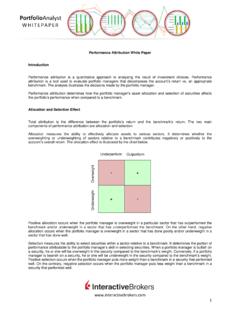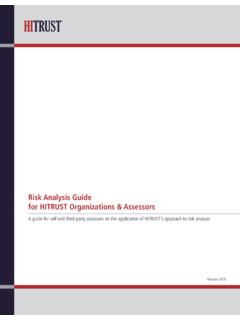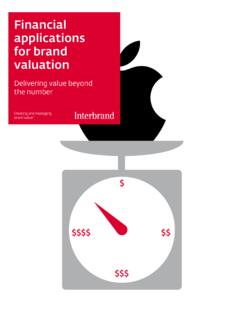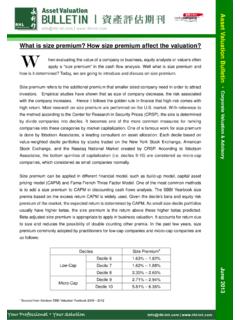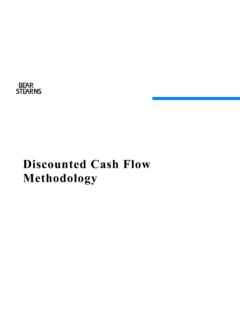Transcription of Introduction to Technical Analysis - Interactive …
1 Introduction to Technical AnalysisAndrew Wilkinson1 Risk DisclosureFutures are not suitable for all investors. The amount you may lose may be greater than your initial investment. Before trading futures, please read the CFTC Risk Disclosure. For a copy, call (203) 618 strategies discussed, including examples using actual securities and price data, are strictly for illustrative and educational purposes only and are not to be construed as an endorsement, recommendation or solicitation to buy or sell securities or commodities. Past performance is not a guarantee of future Brokers LLC is a member of NYSE, FINRA, versus Fundamental Technical Analysis of internals Price Volume Pattern Support Resistance Recognition Fundamental Analysis of externals Economy Management SWOT Strengths Weakness Opportunities Threats Buy/ Sell recommendation3 Technical versus Fundamental Fundamental Analysis leads to price predictions using valuation ratios Technical Analysis uses trend and pattern recognition to predict prices4 What s in a Chart?
2 Charts show the price performance of an underlying asset or security Get overview with at least a 6 month picture Consider your timeframe carefully Charts express prices as lines, bars or candlesticks5 Chart Types Trader Work Station (TWS) displays prices as a: Line Joins closing prices between each specified timeframe Bar Uses an open/high/low/close convention Candlestick More weight attached to session direction Volume and Open Interest Analyst pays attention to the volume associated with move within a given session6 What s the Aim? Define the big picture trend if there is one Compare health of underlying to a benchmark Search for shorter term opportunities Understand the likelihood of immediate up or down movement Define range Establish entry or exit points Determine warning signs of a breach of trend or a pattern reversal7 Trendlines Straight line joining two or more price points Support line depicts upward trend Resistance depicts an area above current price that investors may find hard to breach Both can be horizontal lines Investors may eyeball the trend8
3 TrendlinesA 1450 1250 = 200 target is 1250 200 = 1050B 950 750 = 200 target is 750 250 = 550AB9S&P 500 index overhead resistance10 Chart Patterns Trendlines show prevailing up or down trend Parallel lines depict trading channel Patterns emerge Continuation Reversal Triangle Head & shoulders Wedge Pennant & flags11 TrianglesContinuationContinuationReversa l12 Wedge13 Pennants and FlagsFlags and pennants work best on intra-day charts and sometimes need the technician to use a loose interpretation14 Studies TWS has a variety of commonly used Technical indicators Within a chart, select Charts and Add Study For brief description of any study, use the search box on the IB website15 Moving Averages One of the simplest forms of Analysis Compares average price for x days against a shorter period of y days Buy when more sensitive shorter moving average rises faster than longer period Sell when shorter moving average falls faster than longer period Different securities, indices and instruments require different length of data (one size does not fit all)
4 Common periods are 5, 9, 21, 50, 90 and 200 1617 ADX/DMI Strength of trend indicator Uses two filters (DMI+ and DMI ) The net of these two values is smoothed to create Average Directional Index This index rises to confirm trending prices ADX returns values 0 100 Optimal performance when ADX is between 20 401819 MACD Moving Average Convergence Divergence Employs exponential moving averages Subtracts longer moving average from shorter moving average to create MACD Uses an even shorter exponential moving average to create signal line MACD passing up and down through signal line generates buy and sell signals MACD minus signal also creates histogram also
5 A reliable Technical indicator2021 Parabolic SAR Stop and Reverse May depict the current trend Initially established as a point at which prevailing position should be closed Rising dots below price are long exits Falling dots above price are short exits2223 Pivot Points TWS creates two resistance points above price Two support prices below price Both use previous days high, low and closing prices Pivot point is calculated using a five point system Some traders use these to cluster buy and sell orders for day trading Need to know when either is giving way2425 Relative Strength Indicator (RSI) Looks at a set of user defined data and compares number of up bars versus down bars to create an index Indicator oscillates between 0 100 and confirms market strength Overbought readings range between 80 100 Oversold readings range 0 20 Warning: Some of the best moves occur in these ranges!
6 Useful for finding divergence between price and RSI to show false moves2627 Stochastic Oscillator Creates two lines %k and %d %k looks at most recent closing price and compares to the lowest reading from a specified range and divides by overall period range %d moving average of %k Buy and sell indications occur when %k crosses %d Again useful for confirmation of price action at lows (highs)2829On Balance Volume Volume is a key component to trend development Creates a single line below the chart to show cumulative volume allowing for price direction Daily volume is ADDED when price closes up Volume total is SUBTRACTED when prices fall Use to gauge whether higher volume is supporting up or down trend Drawback is price settlement3031 Accumulate/Distribution Enhanced version of OBV Doesn t consider daily price change Focus on location of close relative to range of closes before adding or subtracting day s volume total AD line
7 Should follow prices Cumulative buying should see line rise Selling en masse should see line decline Looking for divergence between declining prices and accumulation of volume3233 Fibonacci Numbers Series of mathematical relationships Technician believes that history will repeat itself Prices move in predictable waves after a move has been established Key retracement points: 50% Numbers35 Conclusion Technical Analysis is the study of prices Chartist identifies patterns to make predictions Patterns can be numerically evaluated and give rise to numerous studies Valuable work, but you must be prepared to apply various studies to different asset classes and time frames36 Questions?
8 37


